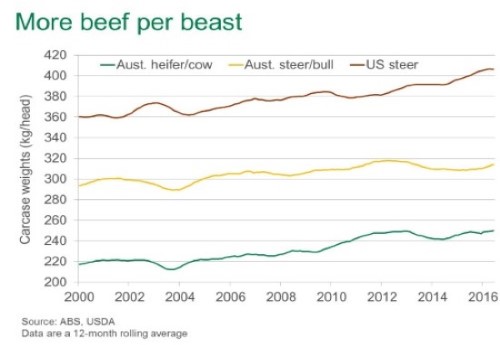Cattle carcase weights on the rise
Australian adult cattle carcase weights have continued to increase throughout 2016, with the improvement in seasonal conditions. In June, adult male and female carcase weights averaged 321kg and 250kg/head, respectively, across the country – both up about 5kg/head on year-ago levels and similar to the previous peak in 2012 (ABS).
Carcase weights have risen with improved pasture availability across much of the country; grassfed cattle are being finished to heavier weights, and the absence of drought is reducing the incidence of cattle being turned-off earlier than desired. In addition, as highlighted in the recent Lot feeding brief, the record numbers of cattle on feed at the end of 2015 have been coming through the supply chain over the past six months, supporting the lift in carcase weights.
Given much of the country has stored up good soil moisture in recent months and the Bureau of Meteorology are forecasting a neutral chance of above average spring rainfall in most regions – compared to drought conditions recorded over the last three years – carcase weights will likely remain above year-ago levels for the remainder of 2016. Given slaughter cattle supplies are tight and expected to remain so through 2017, heavier cattle will go some way to mitigating the decline in beef production.

Interestingly, while some comparisons can be made, Australia is yet to record a similar magnitude rise in carcase weights seen in the US in recent years – the result of expensive cattle and cheaper grain. As illustrated in the figure above, Australian carcase weights remain well below their US counterparts – US steers in June were about 70kg carcase weight heavier than those in Australia. While the genetic pool of cattle may not be dissimilar between the two countries, Australia’s emphasis on grass based production and a relatively shorter grain feeding regime limit how heavy cattle can be finished to.



